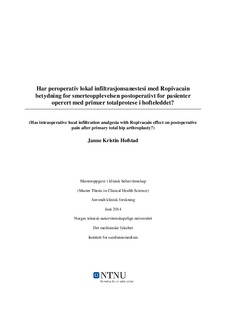Har peroperativ lokal infiltrasjonsanestesi med Ropivacain betydning for smerteopplevelsen postoperativt for pasienter operert med primær totalprotese i hofteleddet?
Master thesis
Permanent lenke
http://hdl.handle.net/11250/281668Utgivelsesdato
2014Metadata
Vis full innførselSamlinger
Sammendrag
Background: The Local infiltration analgesic (LIA) technique has widely been used to
reduce opioid requirements and improve postoperative mobilization following total hip
arthroplasty (THA). However the evidence for LIA in THA remains to be clarified.
Purpose: To evaluate whether a single shot LIA in addition to a multimodal analgesic
regimen would reduce acute postoperative pain and opioid requirements after THA.
Material and Methods: 116 patients undergoing primary THA under spinal anesthetic were
included in this randomized double- blinded placebo- controlled trial. All patients received
oral opioid-sparing multimodal analgesia; Etoricoxib, Acetaminophen and Glucocorticoid.
The patients were allocated to receive either 150 ml Ropivacain 2mg/ml and ½ ml
Epinephrine 1mg/ml, or 150 ml saline 0. 9 %. Rescue analgesic consisted of Morphine and
Oxycodone as needed. The primary endpoint was pain during mobilization in the recovery
unit. Secondary endpoint was pain during mobilization the day after surgery and total
postoperative opioid requirements the first postoperative day.
Results: Pain during mobilization in the recovery unit did not differ significantly between the
two groups (p=0. 7 Mann-Whitney U-test) neither did pain score during mobilization the day
after surgery (p=0. 2 Mann-Whitney U-test). There were no significant difference between the
two groups in postoperative consumption of opioids the first postoperative day.
Conclusions: LIA provides no extra analgesic effect after THA in addition to the multimodal
analgesic regimen used in this study.
